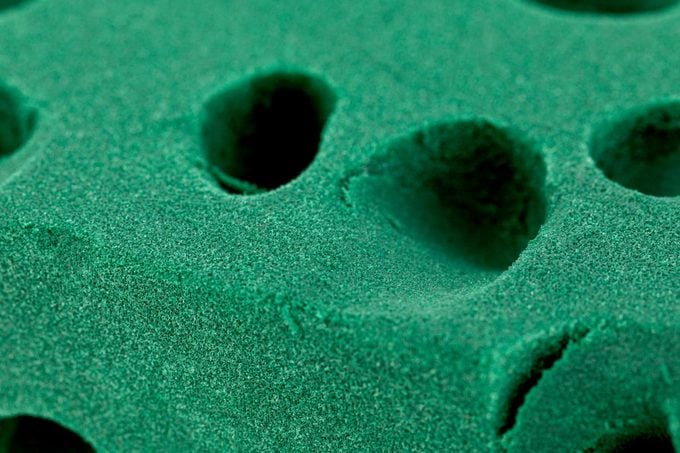Why You Should Never Use Floral Foam
If you’ve ever received a flower arrangement—you might have seen a block of green foam at the bottom of the vase. Floral foam is an absorbent plastic material that can be cut and shaped to fit any flower vessel. It’s used to hold flowers in place and keep them watered through the foams absorption properties.
Since its invention in 1954, floral foam has become a mainstay for professional and hobbyist florists alike. According to a 2019 study by the Royal Melbourne Institute of Technology in Australia, two-thirds of 1,200 global florists surveyed utilized the green stuff.
But while floral foam can be incredibly useful, it also poses real threats to the environment and the health of florists. Here’s everything you need to know about the dangers of floral foam, as well as our favorite alternatives.
Why You Should Never Use Floral Foam

Floral foam is terrible for the environment . “It’s a single-use plastic. It also contains other harmful ingredients such as formaldehyde, and when it breaks down, it adds to the problem of microplastics already in the environment,” says gardening expert Annette Hird.
Bloom College says floral foam blocks will eventually pollute our oceans, calling one block of floral foam “equal to ten plastic bags.” Yikes.
Additionally, the styling tool contains many known carcinogens , like formaldehyde, carbon black and barium sulphates. Per Bloom College: “While the extremely small quantities [of these substances] found in single blocks are not harmful in small doses, long-term exposure could cause side effects.”
Alternatives to Floral Foam
With these dangers in mind, it’s best to turn to safe yet effective floral foam alternatives for all your flower styling needs. Here are five of our favorites.
Chicken wire
Koch, Bloom College and Flower magazine all highlight chicken wire as one of the best floral foam alternatives out there. It’s easy to cut and sculpt, and its mesh holes are perfect for slotting flowers into. Better yet, it’s reusable and “biodegradable via corrosion.”
To use it, simply roll it into a ball and place the ball in a vase, pot or garden container . Then push your flower stems through until they reach the water source.
Flower frogs or kenzans
Flower frogs were originally a tool for the Japanese art of flower arranging, known as Ikebana. In recent years, they’ve gained global popularity thanks to their reusable materials and elegant design.
To use them, first anchor them to the bottom of your vase or flower pot with a florist clay. Then stick the flower stems onto the frog’s pins. That will keep them in place and open them to drink more water.
Water vials
Made of recyclable plastic , these are tiny containers you can push single stems of flowers through. Typically, they’re filled with water, and a small rubber cap holds the stem tightly and keeps it hydrated. They can be used on their own to support flower stems, but are especially great in conjunction with chicken wire.
Wood wool
Traditionally a packing material for wine bottles and food, the fine floss of shredded timber fibers is also excellent for floral design. Much like its tougher dishwashing companion steel wool , wood wool makes tons of little holes for flower stems to poke through. And it adds “that rustic, farm-fresh feel to your arrangements,” according to Bloom College.
Moss
A nice lump of moss can work wonders. Naturally biodegradable, moss provides an excellent sponge to insert flowers and add earthiness to your arrangement. Try to purchase live moss from a wholesaler or online. For extra traction, wrap it in twine or chicken wire.
FAQ
Why do florists still use floral foam if it’s bad for the environment?
Floral foam is a common material and convenient, so many florists still use it. However, knowledge is spreading of its environmental impact ; which will hopefully lead to more and more florists switching to a biodegradable alternative.
Is there a certified biodegradable version of floral foam?
“There are now bio-floral foam alternatives that are much safer to use,” says Hird. Phoam Labs offers a compostable polylactide (PLA) foam, that is non-toxic, non-toxic, made from renewable plant materials, and breaks down into environmentally friendly components.
About the Expert
- Annette Hird is the owner and author of Easy Urban Gardens . Hird has an Associate Diploma in Horticulture and is an urban gardening expert. She has worked as a professional propagator and managed, maintained and improved many urban and rural gardens.
Post a Comment